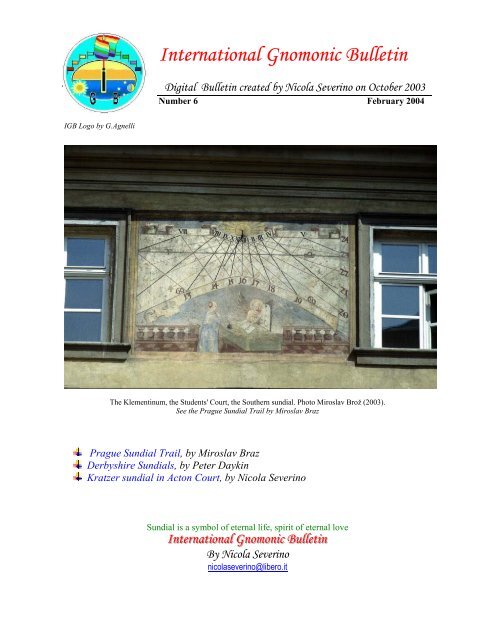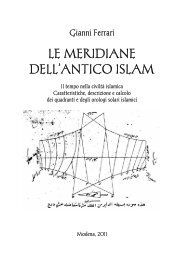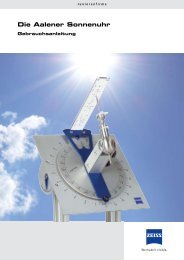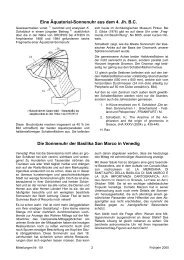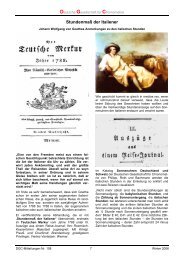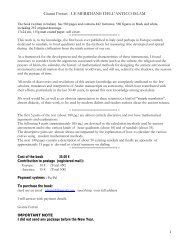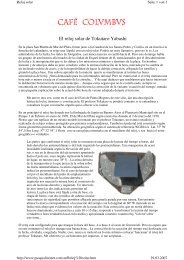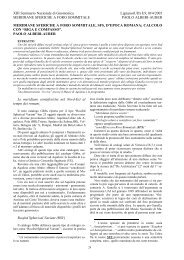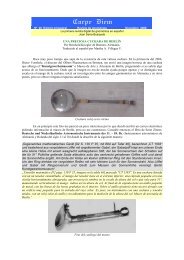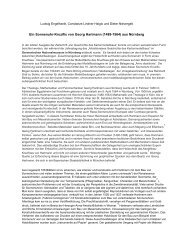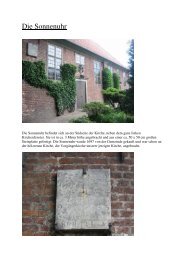International Gnomonic Bulletin - Gnomonica by Nicola Severino
International Gnomonic Bulletin - Gnomonica by Nicola Severino
International Gnomonic Bulletin - Gnomonica by Nicola Severino
Create successful ePaper yourself
Turn your PDF publications into a flip-book with our unique Google optimized e-Paper software.
<strong>International</strong> <strong>Gnomonic</strong> <strong>Bulletin</strong><br />
Digital <strong>Bulletin</strong> created <strong>by</strong> <strong>Nicola</strong> <strong>Severino</strong> on October 2003<br />
Number 6 February 2004<br />
IGB Logo <strong>by</strong> G.Agnelli<br />
The Klementinum, the Students' Court, the Southern sundial. Photo Miroslav Brož (2003).<br />
See the Prague Sundial Trail <strong>by</strong> Miroslav Braz<br />
Prague Sundial Trail, <strong>by</strong> Miroslav Braz<br />
Der<strong>by</strong>shire Sundials, <strong>by</strong> Peter Daykin<br />
Kratzer sundial in Acton Court, <strong>by</strong> <strong>Nicola</strong> <strong>Severino</strong><br />
Sundial is a symbol of eternal life, spirit of eternal love<br />
Intteerrnattiionall Gnomoniicc Bulllleettiin<br />
By <strong>Nicola</strong> <strong>Severino</strong><br />
nicolaseverino@libero.it
Prague Sundial Trail<br />
By Miroslav Brož<br />
This sundial trail will guide you through the heart of the Old Prague, where you can see over<br />
20 splendid sundials. Some of them are situated on famous historical buildings, churches or<br />
monasteries. Not all of them can be spotted easily - it is worth having this guide, a good map of the<br />
Prague center and, of course, a camera with a telephoto lens.<br />
Our trip takes at most one whole day. The trail starts at Prague's main railway station and ends at<br />
the Štefánik Observatory on Petřín hill. (See a map on Figure 1 or [1].) You will have to walk most<br />
of the 7-km path. Twice or three times you can use public transport to visit sundials at places farther<br />
from the town center. We selected mainly sundials on public places, where you will not need any<br />
permission to enter or to photograph. Optionally, you may want to visit the Astronomical Tower in<br />
the Klementinum, Ledeburská Garden or the Štefánik Observatory - in all these an entrance fee has<br />
to be paid.<br />
Figure 1 - The clickable map of the Prague center. Click here for a high resolution map intended for printing.<br />
(1) Let's start the route at the main railway station, where a lot of Prague's visitors arrive. The<br />
nearest sundial is in Jindřišská Street no. 939/20. Walk 300 m to the North-West, directly out of the<br />
station, until you reach a tram railway. Turn left, walk another 200 m along the railway and look for<br />
the Baťa shoe-shop on your left side. Unfortunately, the sundial is not visible from the street, you<br />
must enter the court. This sundial is vertical, South-East declining, with an oblique gnomon and a<br />
nodus. Numbers and lines denote hours from 4 to 12. The outlines probably were of hyperbolic<br />
shape in the past (prior to a reconstruction in 2001), but they are general curves today and thus the<br />
calendar does not work properly.
(2) The second stop is Old Town Square (Staroměstské náměstí): continue <strong>by</strong> Jindřišská Street to<br />
Wenceslas Square (Václavské náměstí), turn right and walk down the square, via Na můstku and<br />
Melantrich Streets. 1 You should stop just in the front of the Prague Astronomical Clock (Pražský<br />
orloj).<br />
The instrument was manufactured in 1410 <strong>by</strong> Master Mikuláš of Kadaň, the designer was Jan<br />
Ondřejů, called Šindel (1375-1445). As with all middle-age clocks, it had to be equipped with a<br />
sundial to set the precise time. None has survived to today, but two dials were visible at the<br />
beginning of the 20 th century. They were installed during the reconstruction of the clock in 1790, led<br />
<strong>by</strong> the director of the Klementinum observatory Antonín Strnad (1749-1799), who probably was the<br />
designer of the sundials too. Even before, in the 16 th century, there were situated two sundials,<br />
positioned a little bit lower, at the level of the bottom dial, not at the level of the Apostles windows.<br />
What does the astronomical clock show? The hour finger, with a golden hand and a symbol of the<br />
Sun, shows (i) the Central European Time (on Roman numbers on the fixed dial), (ii) Italian hours,<br />
ie. time left from the sunset of the previous day (on Gothic numbers on the outer movable dial) and<br />
(iii) planetary hours (on the gold bows with black Arabic numbers). The last ones are of unequal<br />
length, because the time-span, when the Sun is above the horizon, is always divided to 12 parts,<br />
regardless of the different lengths of a "white" day in different seasons. The hand with a star shows<br />
the sidereal time (on the dial with Roman numbers). It is firmly connected with the gold eccentric<br />
circle - the ecliptic. The signs of zodiac, in which the Sun and the Moon are currently located, are<br />
clearly visible on the ecliptic. The symbol of the Sun is connected with both the hour hand and the<br />
circumference of the ecliptic, which rotates faster (approximately <strong>by</strong> 4 minutes per day). Thus the<br />
solar symbol orbits the ecliptic once per year. It is located nearer the dial center (ie. lower in the<br />
sky) during winter months and, to the contrary, farther away (ie. higher) during summer months.<br />
The area of the dial is divided into three coloured parts: the light blue denotes the daylight sky, the<br />
purple denotes nightfall and twilight, the black colour represents the night. All these help one to<br />
read the azimuths and altitudes of celestial bodies and the times of their rising and setting. The<br />
black field does not reach the dial border, which corresponds to the situation, that there is not an<br />
astronomical night does not set in out country during summer. One can also recognize the phase of<br />
the Moon. An ingenious mechanism inside the half silver-painted ball forces its rotation once per<br />
synodic month <strong>by</strong> daily motion of the hand with the Moon "upwards and downwards". There is a<br />
circular painted calendar below the astronomical clock. It rotates once per year and an arrow on the<br />
top indicates the current day.<br />
(3) Another dial, rather unusual, is a few tens of metres to the North-East from the clock - the<br />
Meridian of Prague is marked on the pavement. The Mariánský column, which stood in the middle<br />
of the square, served as a gnomon. Sadly, it was demolished in 1918, during the period when<br />
Czechoslovakia was founded.<br />
You may also visit the Týn Church, on the Eastern side of the square, where Tycho Brahe (1564-<br />
1601) is buried. His tomb is inside the church.<br />
(4) The highest concentration of sundials in the Czech Republic is surely at the Jesuit College of<br />
St. Clement (the Klementinum), now the housing of the National Library. Walk from the Prague<br />
clock West to the Small Square and turn right and then left to Linhart Street. Enter the main gate of<br />
the Klementinum.<br />
Only 3 out of the 5 courts are publicly accessible. You can see two East facing sundials through<br />
railings on the Economic Court (Hospodářský dvůr), at the third floor level. Another two South<br />
facing dials are barely visible. They are dated back to 1658-1662 (as inscriptions confirm) and their<br />
author was most probably Jesuit astronomer Valentin Stansel (1621-1705). Most of sundials are
ichly painted (they display biblical motifs) and moreover, they are gnomonically interesting.<br />
Eg. the right Eastern dial on the Economic Court (Figure 2) indicates time from the most recent<br />
sunset (so called Italian hours). Its calendar consists of 3 declination curves for solstices and<br />
equinoxes. The Latin inscriptions read: "NON SOLO PANE VIVIT HOMO" ("A man does not live<br />
of bread only") and "ET VERBUM CARO FACTUM EST" ("A word becomes a body").<br />
Figure 2 - The Klementinum, the Economic Court, the right Eastern sundial. Photo Miroslav Brož (2003).<br />
(5) Let us inspect the Astronomical Tower. It was built as a look-out tower in 1720s, when František<br />
Retz (1730-1750) was the head of the monastery. Astronomical instruments were installed and<br />
regular astronomical observations began much later - in 1750s. The observatory was firstly led <strong>by</strong><br />
Josef Stepling (1716-1778). 2<br />
A complete sundial is visible on the Eastern wall (Figure 3), a style without a dial is on the opposite<br />
side. In the past there was probably a sundial also on the Southern side and possibly even on the<br />
Northern one. The decoration of the Eastern sundial, secession ornaments, differs from the other<br />
sundials in the Klementinum.<br />
Figure 3 - The Astronomical Tower in the Klementinum, the Eastern sundial. Photo Miroslav Brož (2002).<br />
However, the most compelling sundial is hidden inside the tower: a noon aperture sundial, the most<br />
precise in Bohemia. (If you would like to see it, you should note that the opening hours are from<br />
March to September, Mon-Fri 14-19, Sat-Sun 10-19 and the entrance fee is 100 CZK, ie. 3 EUR.)<br />
There is a small hole in the Southern wall of the tower, which serves as a camera obscura. The solar<br />
disk is projected on the inner floor and wall. The disk is divided into the two halves <strong>by</strong> an iron wire
at the moment of the local apparent noon. The accuracy of such time measurements is several<br />
seconds.<br />
(6) Leave the tower, noticing a meteorological box, where measurements of temperature have been<br />
taken since 1775 (it is the world's longest continuous set of such data). Walk to the Students' Court<br />
(Studentské nádvoří). Two splendid sundials are on the Southern (Figure 4 on this IGB cover – title<br />
page) and the Eastern walls (Figure 5 below). Their styles are perpendicular to the walls and have<br />
noduses. They show three times at once: usual local apparent time (L.A.T.), time left from sunrise<br />
(so called Ba<strong>by</strong>lonian or Bohemian) and time left from sunset of the previous day (Italian). There<br />
are 3 declination lines on the dials. The Eastern sundial is decorated <strong>by</strong> a painting of a skeleton with<br />
a scythe and a sand-glass. The Southern one has a scene of an angel showing the Ten<br />
Commandments to a praying woman.<br />
Figure 5 - The Klementinum, the Students' Court, the Eastern sundial. Photo Miroslav Brož (2003).<br />
Other 6 sundials in very good condition are inside the Vine Court (Révové nádvoří), which is<br />
unfortunately closed to the public. However, some of them are visible from the tower.<br />
(7) We are about to leave for the Little Quarter (Malá Strana). Just three last recommendations:<br />
there is a sundial symbol in Platnéřská Street no. 7 (it is the street along the Northern side of the<br />
Klementinum). Johannes Kepler (1571-1630), the author of the famous three laws of celestial<br />
motion, lived in Karlova Street no. 4, just along the Southern Klementinum's wall. And finally,<br />
there is St. Kliments Chapel near<strong>by</strong>, which has an elliptical ground plan. (Speculations arose, that<br />
this shape could have inspired Kepler in his discovery of the first law.)<br />
(8) Now cross Charles Bridge (Karlův most), on the opposite river-side, in front of the bridge tower<br />
turn right to "U lužického semináře" Street and enter into the Vojan Orchards (Vojanovy sady).<br />
There is a large vertical sundial on the outer wall of the whitefriar monastery (Figure 6). It is a<br />
simple South facing dial with lines and numbers from the VI th morning hour until the IV th afternoon<br />
hour, but the painting and the decorations are complex and very nice.
Figure 6 - Vojanovy sady. Photo Miroslav Brož (2003).<br />
(9) The next stop is on Klárov - leave the garden and continue along the street in the same Northern<br />
direction as before, until you come to a big tram crossroads. The Eastern sundial (Figure 7) is best<br />
visible from the tram stop. It is located behind a high fence, on a stair tower, inside a restricted area<br />
of the Archaeological Institute. There is a breathtaking view of Prague Castle in the background.<br />
The dial consists of hour lines, numbered from 4 to 10, and seven declination hyperbolas. The<br />
decoration is composed of two angels, the Sun and the Earth.<br />
Figure 7 - Klárov (Letenská Street no. 123). Photo Miroslav Brož (2003).<br />
(10) We now move toward the Little Quarter Square (Malostranské náměstí). Walk over Valdštejn<br />
Street, because there is an entrance to the Ledeburská garden, with a sundial situated between the<br />
2 nd and the 3 rd terrace (Figure 8). An entrance fee 80 CZK has to be paid, but this sundial is<br />
definitely worth seeing. It is painted on a proclining plane (the perpendicular points to below the<br />
horizon). The Latin inscription reads: "CLARET IN ORBE DIES AC TETRAS HORA PETE<br />
UMBRAS" (in English "A day is shining in the world and you, the hour, scare away grim<br />
shadows").
Figure 8 - The proclining sundial in the Ledeburská garden. Photo Martin Šolc<br />
(11) A small sundial is secreted in the near<strong>by</strong> street "U zlaté studně", on the Painter House<br />
(U Malířů). The whole Southern wall is richly decorated <strong>by</strong> frescos, as the name of the house<br />
suggests. It is difficult to photograph the dial, since the street is rather narrow.<br />
(12) Take Sněmovní Street alongside the Czech Parliament and walk another 200 m to Little<br />
Quarter Square. There are two sundials on the house in the North-Eastern corner. The one facing<br />
the square indicates L.A.T. and Italian hours, it is oriented towards the South. The second one, at<br />
the beginning of Tomášská Street, is East facing (Figure 9). Apart from L.A.T. and Bohemian hours<br />
there is a calendar on the dial. The two sundials were discovered relatively recently, in 1994, during<br />
a complete reconstruction of the building, even though they are almost 400 years old.<br />
Figure 9 - Tomášská Street. Photo Martin Šolc (2000).<br />
(13) Take Nerudova Street, approximately 500 m to the West, towards the crossroads with Ke hradu<br />
Street. You should use binoculars to spot a noon sundial on a chimney of Swarzenberg Palace.<br />
(Look for it in the NNW direction.) There is a noon mark only on the dial and some decorations<br />
with a cock and an owl. It should be mentioned, that this sundial is the oldest one existing today in<br />
Prague - it was created in 1567.<br />
(14) The next sundial is visible from Loreta Square. You can use either the longer way along Prague<br />
Castle or the shorter one over the Town-hall stairs, it is 400 m to the West. The best place to take a
snapshot is on the stairs of the Loreta building. The Eastern dial is located below eaves of the<br />
monastery's church of Panna Marie Vítězná. It is painted in blue and red colours, with white angels<br />
and black and white label: "OMNI HORA ORA" ("Remember the last hour"). It is dated to 1686.<br />
Another two sundials are not visible, in the restricted area of the capuchin monastery.<br />
(15) Now one has to walk more than 1 km in SSE direction towards the Štefánik Observatory. The<br />
nicest way is over an orchard below Strahov 3 and along the Petřín Look-out Tower. An<br />
extraordinary modern sundial is just beside the entrance and the statue of M. R. Štefánik. Three<br />
wings cast shadows on four dials. There is a separate analemma to allow conversion of Local<br />
Apparent Time to Mean Solar Time. Because of gnomons' thickness, there are vertical gaps clearly<br />
visible on the dials. The sundials are made of concrete, the lines of steel cables. They were created<br />
in 1976 <strong>by</strong> O. Hlad and P. Vilímek.<br />
There is one precious portable sundial exposed in the interior of the observatory (Figure 10). Its<br />
author is Jan Engelbrecht (1726-1807). He and his son Antonín constructed many gnomonically<br />
valuable sundials, both portable and fixed, in the second half of the 18 th and at the beginning of the<br />
19 th century. The sundial consists of a horizontal dial with a fixed oblique gnomon and an<br />
analemmatic dial with a movable vertical gnomon. This configuration has the advantage, that no<br />
compass is necessary to orient the sundial (and consequently a magnetic declination does not affect<br />
time measurements). One has only to set up the position of the gnomon according to the current<br />
date and then rotate the sundial until both dials show the same time.<br />
Figure 10 - The Engelbrecht's portable sundial exposed at the Štefánik Observatory. Photo Miroslav Brož (2003).<br />
(16) The very last stop is near<strong>by</strong>, in Kinski Garden (Kinského zahrada). Walk from the observatory<br />
300 m to the South, firstly turn slightly right around a rose bed and after 200 m sharply to the left<br />
and then steeply down towards the upper lake. There is a column with four sundials facing four<br />
directions, but not cardinal points. The work originates in 1686. Every dial is a relief with a biblical<br />
person: Jesus Crists (on the South-East), St. Roch (SW), St. Rozalie (NW) and St. Šebestián (NE).<br />
An at-first-sight-similar column was built in 1737 in the Malvazinky cemetery, Smíchov Quarter.<br />
(17) Let us recommend to you a few additional places, that you can reach easily <strong>by</strong> public transport.<br />
Břevnov Monastery is 2.5 km to the West from Loreta Square (14), ie. four stops <strong>by</strong> a tram no. 22. 4<br />
In Břevnov you can see two Southern and one Eastern sundials in the inner court of the monastery.<br />
The Southern dials are richer from gnomonical point of view. The left one indicates Italian hours
(Figure 11) and the right one Bohemian hours. The Eastern dial is simple, but it depicts the person<br />
of St. Benedikt pointing to the Sun. Interestingly, the yellow colour of the Sun is not correct. It<br />
should be painted in black, since Benedikt was prophesying the time of a total solar eclipse. The<br />
fourth sundial is curious - it is a small mirror in the bottom part of a window, which reflects the<br />
Sun's rays onto a ceiling with a dial and a painting (Figure 12). One can perhaps see it during<br />
guided visits of the monastery.<br />
Figure 11 - The left Southern sundial in Břevnov. Photo Miroslav Brož (2002).<br />
Figure 12 - The mirror dial inside Břevnov Monastery. Photo Martin Šolc.<br />
(18) The National Technical Museum holds a permanent exhibition of astronomical instruments,<br />
clocks and portable sundials. You can get there from Klárov (9) <strong>by</strong> crossing Letná Park on foot<br />
(1.5 km to ENE) or with help of a no. 12 tram. The opening hours are daily except Monday, from<br />
9 to 17 o'clock.<br />
(19) There are another two fixed sundials in the near<strong>by</strong> Stromovka Park (0.5 km to the North from<br />
the museum). The first, a usual horizontal one, is built in the front of Prague's Planetarium.<br />
(20) The second sundial, to the side of the Governors Summer Castle (Místodržitelský letohrádek)<br />
on the South-West border of Stromovka, is unique. It is of a spherical type with a movable<br />
indicator. The dial contains hour circles, projections of the equator, the tropics, the ecliptic, the<br />
poles and also two divisions to temporal hours. It was installed already in 1698. Moreover, there is a<br />
beautiful view of the park, the valley of Vltava and the opposite river-side from the corner of the<br />
castle. There are many other sundials in Greater Prague, in total over 100. There is insufficient<br />
space to describe them in detail here. We only mention for example the Jan Engelbrecht's historic<br />
sundial in Cibulka Court, the modern sundial on a generally oriented plane in Famfulíkova Street
no. 1139, Ďáblice housing estate, or a big horizontal one in front of the Agriculture University in<br />
Suchdolská Street no. 9.<br />
A complete and continuously updated Internet database of sundials in the Czech Republic and<br />
Slovakia can be found at the URL http://www.astrohk.cz/slunecni_hodiny.html.<br />
[i] An image list of all sundials in Prague<br />
[ii] A map of Prague with sundials locations<br />
[2] Polák, B.: Staropražské sluneční hodiny. Academia, Praha, 1986.<br />
The book "Sundials on fixed locations. Bohemia, Moravia, Silesia and Slovakia" (in Czech<br />
language with an English summary) will be published <strong>by</strong> Academia publishing<br />
(http://www.academia.cz) in mid-2004.<br />
1 There is a memorial plaque of Marcus Marci de Kronland (1595-1667) in Melantrich Street.<br />
2 The most important discovery in the Klementinum was held in 1889-1890: approx. 10 m motion of the spin axis in the<br />
Earth's body was recognized.<br />
3 There are six sundials next to each other on the same wall in Strahov Monastery, to where an entrance is restricted.<br />
4 A statue of Kepler and Tycho Brahe is near<strong>by</strong> the tram-stop at Pohořelec.
Sundials on Kedleston Church<br />
Der<strong>by</strong>shire Sundials<br />
By Peter Daykin<br />
This unusual vertical direct east dial is on a panel fixed over the east gable of the chancel of All Saints<br />
Church. It is a copy of the original dial, and dates from 1912. Because of its orientation, the dial only catches<br />
the sun between the hours of 6 and 11am. It can be seen that the hour lines are parallel with each other, with<br />
half hour lines in between. The gnomon, green with verdigris, to the top left of the dial, is in the form of a<br />
letter "T", the top bar of the T casting a shadow across the dial.<br />
The inscription above the dial is "WEE SHALL", and when followed <strong>by</strong> a pun on sundial (soon die all) gives a<br />
rather sombre message, which is reinforced <strong>by</strong> the carvings on top of the dial panel, showing a skull<br />
between two hour glasses.<br />
The church at Kedleston dates from the 12th century and lies behind a wing of Kedleston Hall. In about 1700<br />
the east gable of the church was altered to be more in keeping with the house which then existed and this<br />
impressive sundial was originally erected. It faces the bedrooms of the present Hall.<br />
This was the church of Kedleston village, but the village was eventually moved away from the hall. Three<br />
halls have stood on this site, the present one begun in1759.<br />
The church is now in the ownership of the Churches Conservation Trust, and can only be visited when the<br />
Hall grounds are open to the public.<br />
On the wall under a south facing window is this ancient scratch dial. It is 10½" (27cm) wide, and<br />
consists of a double semi-circle and radiating lines. At the centre was a hole, now filled in, for a<br />
stick gnomon which would have protruded from the wall. The time being taken from where the<br />
shadow passed the combination of lines and small shallow holes.
Cube Sundial on Ashover Church<br />
The cubic sundial stands over the porch gable of All Saints church.<br />
It is in fact 3 vertical sundials engraved onto one block of stone.<br />
There is a direct south facing dial seen in detail in the first picture, a<br />
direct west dial to the left, and direct east to the right.<br />
Although the stone surface is discoloured with age, the hour lines can<br />
be clearly seen in this view, as can some Roman numerals. The iron<br />
gnomon is badly corroded and most of it is missing. The simple bars<br />
used for east and west dials are however intact.<br />
The Church warden's Accounts give the dates and cost to the parish of<br />
installing and cleaning the sundial:<br />
"1780 June 25.<br />
To William Wheatcroft for painting and figuring the Sun Dial<br />
... 10s 0d."<br />
"1823 Sept 6. To Geo Bamford for taking down Sundial, Cleaning etc., 2 days at<br />
3s 6d.<br />
... 7s. 0d.<br />
The total expenditure in modern terms is £0.85. Allowing for inflation and increased costs the total would now<br />
run into hundreds of pounds.<br />
C E Lugard, writing in 1924, said the dial was dated 1823,<br />
(the year the church wardens accounts record that it was<br />
restored).<br />
It was already fading when F N Fisher saw it 12 years later<br />
and read it as 1825. The dial also showed the latitude of 53°.<br />
When we visited in September 2000, traces of an inscription<br />
could be seen at the top of the south face, but it was too faint<br />
to be readable.<br />
References:<br />
F N Fisher -<br />
A letter in Der<strong>by</strong>shire Advertiser Notes and Queries,<br />
Volume 13, page 62. Dated 22nd May 1936.<br />
C E Lugard -<br />
"The Saints and Sinners of Ashover" 1924<br />
The village of Ashover
Sundial on Bakewell Church<br />
This round sundial is on the wall above and to the right of the porch doorway of All Saints Church, Bakewell.<br />
Large areas of the dial face have crumbled away with age, (see enlarged clip at the foot of this page), and<br />
little can be seen of the original markings from ground level. Close examination of the photograph shows<br />
evidence of Roman numerals around the dial. The date above the gnomon cannot be made out here, but is<br />
MDCCXCIII. According to an article in the Der<strong>by</strong>shire Advertiser Notes and Queries of 1935, the dial once<br />
bore an inscription which read "In such an hour the Son of Man cometh" and the date 1793.<br />
This quotation has completly gone, but was probably above the date. The small gnomon, possibly made of<br />
brass, is covered in green verdigris.<br />
The photograph was taken at 1:15 pm in July 2000.<br />
The church stands halfway up the hill on the west side of the town, its spire a landmark. Parts of the present<br />
building date from the 12th century, but many Anglo-Saxon stone fragments, on view in the porch, are<br />
evidence of an earlier foundatio
SUNDIALS IN BASLOW CHURCHYARD<br />
An unusal memorial sundial is to be found in the church yard of st Anne's.<br />
The dial is in the form of a leaning cross mounted on top of a round column.<br />
The cross leans towards the south, and should make an angle equal to the co-latitude<br />
between the mainshaft of the cross and its octagonal base.<br />
Hour lines are engraved on the top of the cross arm, the<br />
shadow being cast from the top edge of the leaning mainshaft.<br />
The west arm shows the morning hours, and the east arm the<br />
afternoon hours.<br />
The east and west sides of the leaning mainshaft are also<br />
engraved with hour lines and Roman numerals.<br />
On the east face of the mainshaft, for the hours before 6am<br />
they are above the cross arm, and for the hours after 6am the<br />
morning hours are found below the cross arm, the shadow<br />
being cast from the end edge of the cross arm. The afternoon<br />
hours are engraved down the west side.<br />
On the south face is engraved the year 1891, and on the north<br />
face of the cross is engraved the verse:<br />
"If o'er the dial glides a shade, redeem<br />
the time, for lo, it passes like a dream.<br />
But if 'tis all a blank, then mark the loss<br />
of hours unblessed <strong>by</strong> shadows from the cross".<br />
The column that supports the dial is now leaning a few degrees due to subsidence.<br />
The sundial stands within a kerbed area containing the graves of Edward Mason Wrench<br />
and members of his family, and is a memorial to them, their names being inscribed on the<br />
column. Also to be found in the churchyard is a metal Horizontal dial mounted on a stone<br />
pillar rising from stone steps. The dial face is square and engraved in Roman numerals.<br />
The dial is encrusted with green verdegris which hides most of the engraving.
DECLINING WALL SUNDIAL ON EYAM CHURCH<br />
The impressive west declining sundial stands on two corbels projecting from the wall above the doorway to the south aisle of Eyam<br />
Church.<br />
The dial dates from 1775, and was designed <strong>by</strong> a Mr Duffin. Local stone mason William Shore carried out the work.<br />
The hour is read from the shadow cast <strong>by</strong> the gnomon, the dial is engraved to local time, and reads approx' one hour slow during<br />
British Summer time. Lines of declination cross the face of the dial from left to right. This detail, seen on the right from near the top of<br />
the dial face, shows the winter month labelling of the arches.<br />
A protrusion under the gnomon as seen in its shadow follows these lines, indicating the month and sign of the zodiac.<br />
Names of various places in the world are arranged around the gnomon near to the top of the dial. As the shadow passes over a<br />
name, it indicates noon at that particular location.<br />
The Latin engraving at the top of the dial translates as "Cultivate an<br />
enquiring mind", and on the corbels, "Like a shadow, so passes life".<br />
Names of two contemporary church wardens - William Lee and<br />
Thomas Froggat - can be seen near the top.<br />
This picture was taken at 10am BST in mid July. The sun is still too far east to fall on the dial, but it can be seen catching the end of<br />
the right corbel.<br />
The detail picture higher up this page is taken from the Tropic of Capricorn line. The village of Eyam is known for the well<br />
recorded effects of the great plague of 1665-6. The sundial can be seen between two trees that are growing<br />
close to the church.
Mugginton ... Scratch dial<br />
Fisher (1935), described a transitional dial in two parts on the buttress at the<br />
south east corner of the church. The left hand part had a metal gnomon, with<br />
lines ending in Roman numerals from XI to III with dots of the same number<br />
underneath, while on the right hand side the gnomon was missing, but the<br />
numerals from IX to I and the dots were there.<br />
When visited in January 2001, we found the gnomon on the left (south west)<br />
side of the buttress at a height of about 9 feet, it was corroded to the extent<br />
that it had separated into two pieces, the only marking still visible on the wall<br />
is the Roman numeral III. The hour lines are no longer visible.<br />
However the right (south east) side is in a better state of preservation. Holes<br />
can be seen where the gnomon was mounted, and other holes possibly going<br />
back to earlier scratch dial origins. From the top hole hour lines can be seen<br />
radiating out to Roman numerals IX, X, I and II, and a pattern of holes similar<br />
to ::::<br />
North Wingfield ... Horizontal dial<br />
The dial was missing when viewed in November 2000 from this horizontal sundial in the churchyard of St<br />
Lawrence. The pedestal remains, about 5 feet in height overall, it has a square base with a step on one side,<br />
a round column, with a square stone top. The octagonal shape of the<br />
missing dial is outlined in a lighter shade on the dark stone.<br />
... Scratch dial<br />
Fisher (1935) described a dial on the easternmost buttress of the south<br />
side of the chancel, at a height of 63 inches, consisting of a double semi<br />
circle of 6 inches dia. At that time the lines seen were mostly to the east,<br />
the west side being badly weathered.<br />
When we visited in November 2000, we were unable to find any trace of<br />
the dial, although it was mentioned in a village guide of 1986. The surface<br />
of the stones was flaking, perhaps as a result of industrial pollution.
Kratzer Sundial at Acton Court<br />
During recent archaeological excavations at Acton Court, there were many exciting finds, thought<br />
to be associated with King Henry’s visit. These included examples of the finest Venetian glass of its<br />
time, Spanish ceramics, and some of the earliest clay tobacco pipes yet discovered. Dating from the<br />
late 16th century, these support the view that Sir Walter Raleigh gave one of the first<br />
demonstrations in England of the technique of smoking during a visit to Acton Court.<br />
One item of particular importance was found <strong>by</strong> chance in a nettle patch next to the building. It is a<br />
Cotswold limestone sundial designed <strong>by</strong> the royal horologist, Nicholas Kratzer, dated 1520.<br />
Acton Court will reopen next summer from 16 June to 23 August<br />
2004, not Mondays except Bank Holidays. Visits must be prebooked,<br />
for more information telephone: 01454 228 224<br />
Please visit our site later in the year for full details of the House and<br />
our programme of Special Events.<br />
Text and photo <strong>by</strong> http://www.actoncourt.com/location/index.html<br />
Acton Court Latteridge Road Iron Acton Bristol BS37 9TJ<br />
Internet curiosity<br />
Sundial Japan - Circa 1000 BCE<br />
NONAKADO STONE CIRCLE<br />
This stone monument is the best known of its<br />
kind in Japan. It sits in the Kazuno district of<br />
Akita with another group of stones called the<br />
Manza. On a 560 foot high terrace, the Nonakado<br />
consists of two concentric settings of close-set<br />
stones forming belts up to 33 feet wide. The<br />
entire configuration is about 140 feet in diameter.<br />
From the center lying towards the northwest<br />
segment is the famous sun dial. It is made up of a<br />
standing menhir at the center surrounded <strong>by</strong> long<br />
stones placed on their sides and radiating out<br />
from the center.<br />
The sundial is about 36 feet in diameter and the standing menhir is 14 feet 9 inches high.<br />
Excavations at this site has produced stone axes, stone scepters, pottery and other stones vessels.<br />
The purpose of this stone circle is still debated, but giving the similar structures in the Negev<br />
desert and other parts of the world its was probably used to connect the people with the heavens.<br />
Other similar sites in Japan are rare, but the one in the district of Hokkaido is venerated and<br />
offerings of sake are made to it.
Agnelli Cartoons<br />
"THE SUNDIAL MAKES WATER"<br />
1 - THE SUNDIAL MAKES WATER:<br />
… but what do you say? And' a Solar Clock for when it rains.<br />
2 - I tell you him me. .. and if I am me that I tell you him, you can believe us: automatically<br />
suit him for the atmospheric conditions.<br />
3 - Oddio! We are fried.<br />
4 - No, dear colleague: the “frying -pan-gnomonica” has a hole and makes to extinguish the fire.<br />
5 - But as? Doesn't the fire make them fry?<br />
6 - No! From the “frying–pan” water goes down and then everything is refrigerated.<br />
7 - She thinks, is there also the water Sundial, now… that they will still invent you?<br />
8 - It was right my grandmother: has never been ended to learn!


